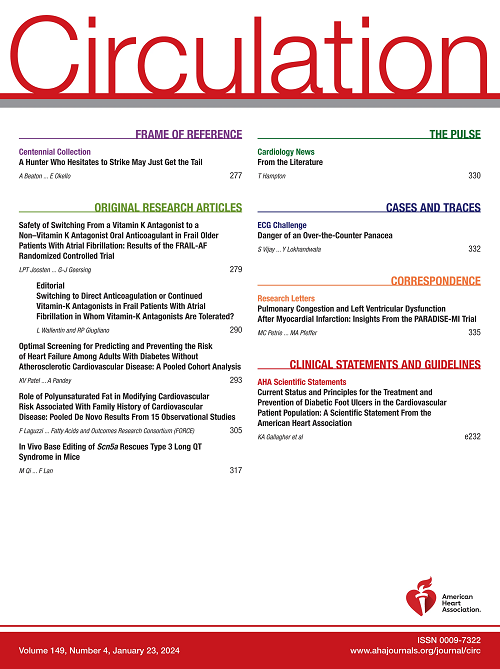Hypercontractility and Oxidative Stress Drive Creatine Kinase Dysfunction in Hypertrophic Cardiomyopathy.
IF 38.6
1区 医学
Q1 CARDIAC & CARDIOVASCULAR SYSTEMS
引用次数: 0
Abstract
BACKGROUND Hypertrophic cardiomyopathy (HCM) is a prevalent inherited cardiac disorder marked by left ventricular hypertrophy and hypercontractility. This excessive mechanical workload creates an energetic mismatch in which consumption exceeds production, leading to myocardial energy depletion. Although CK (creatine kinase) plays a key role in cardiac energy homeostasis, its involvement in HCM remains unclear. This study investigates how hypercontractility-driven mitochondrial stress and the resulting increase in mitochondrial H2O2 disrupt CK function in HCM. METHODS CK function was analyzed using myocardial left ventricular tissue from 92 patients with HCM (with and without pathogenic sarcomere variants) and 30 non-failing human controls. Myofilament and mitochondrial CK isoforms were measured using mRNA analysis, protein immunoblotting, enzyme activity assays, mass spectrometry, and redox-sensitive proteomics. To explore links between hypercontractility, mitochondrial reactive oxygen species, and CK dysfunction, we used isolated cardiomyocytes from wild-type, mitochondrion-targeted catalase-overexpressing, CK knockout (myofilament and mitochondrial CK deletion), HCM-associated Mybpc3 knockin, and mito-roGFP2-Orp1 mouse models. We also tested the effects of the Ca2+ sensitizer EMD-57033, the CK inhibitor 1-fluoro-2,4-dinitrobenzene, and the myosin inhibitor MYK-581, a mavacamten derivative. RESULTS Our analysis revealed significant reductions in myofilament and mitochondrial CK protein levels, as well as CK activity, in myocardium of patients with HCM, primarily because of oxidative modifications of CK. In isolated mouse cardiomyocytes from wild-type and CK knockouts, hypercontractility induced by EMD-57033 elevated mitochondrial H2O2, causing cellular arrhythmias and CK inactivation. Hypercontractility-induced oxidative stress, arrhythmias, and CK dysfunction were also observed in Mybpc3 knockin cardiomyocytes. Mitochondrion-targeted catalase-overexpressing mice with enhanced H2O2 scavenging were protected against H2O2-induced (EMD-57033-mediated) arrhythmias and CK dysfunction. MYK-581 treatment in Mybpc3 knockin cardiomyocytes reduced hypercontractility, lowered H2O2 production and arrhythmias, and preserved CK function. CK inhibition using 1-fluoro-2,4-dinitrobenzene in wild-type cardiomyocytes elevated mitochondrial H2O2 levels and triggered cellular arrhythmias. This mitochondrial oxidation was independently confirmed in mito-roGFP2-Orp1 cardiomyocytes exposed to 1-fluoro-2,4-dinitrobenzene. Mitochondrion-targeted catalase-overexpressing mice were protected from 1-fluoro-2,4-dinitrobenzene -induced oxidative stress and arrhythmogenic events. CONCLUSIONS This study reveals a mechanistic link between hypercontractility, mitochondrial reactive oxygen species, and CK dysfunction in HCM, perpetuating a cycle of energetic dysfunction. Targeting hypercontractility and oxidative stress through myosin inhibition offers a strategy to restore energy balance and reduce arrhythmic risk in HCM.肥厚性心肌病患者的过度收缩和氧化应激驱动肌酸激酶功能障碍。
背景肥厚性心肌病(HCM)是一种常见的遗传性心脏疾病,其特征是左心室肥厚和过度收缩。这种过度的机械负荷造成能量不匹配,消耗超过生产,导致心肌能量耗竭。虽然CK(肌酸激酶)在心脏能量稳态中起关键作用,但其在HCM中的作用尚不清楚。本研究探讨了高收缩性驱动的线粒体应激和由此导致的线粒体H2O2增加如何破坏HCM中的CK功能。方法利用92例HCM患者(伴有或不伴有致病性肌瘤变异)和30例正常对照的心肌左心室组织分析sck功能。使用mRNA分析、蛋白质免疫印迹、酶活性测定、质谱分析和氧化还原敏感蛋白质组学测量肌丝和线粒体CK同工型。为了探索心肌过度收缩、线粒体活性氧和CK功能障碍之间的联系,我们使用了野生型、线粒体靶向过氧化氢酶过表达、CK敲除(肌丝和线粒体CK缺失)、hcm相关Mybpc3敲除蛋白和mito-roGFP2-Orp1小鼠模型的分离心肌细胞。我们还测试了Ca2+敏化剂EMD-57033、CK抑制剂1-氟-2,4-二硝基苯和肌球蛋白抑制剂MYK-581(一种马卡camten衍生物)的作用。结果我们的分析显示HCM患者心肌肌丝和线粒体CK蛋白水平以及CK活性显著降低,这主要是由于CK的氧化修饰。在野生型和CK基因敲除的小鼠心肌细胞中,EMD-57033诱导线粒体H2O2升高,导致细胞心律失常和CK失活。在Mybpc3敲入的心肌细胞中也观察到过度收缩引起的氧化应激、心律失常和CK功能障碍。线粒体靶向过氧化氢酶过表达的小鼠具有增强的H2O2清除能力,可以防止H2O2诱导的(emd -57033介导的)心律失常和CK功能障碍。MYK-581治疗Mybpc3敲入心肌细胞可降低心肌过度收缩性,降低H2O2产生和心律失常,并保留CK功能。在野生型心肌细胞中使用1-氟-2,4-二硝基苯抑制CK可提高线粒体H2O2水平并引发细胞性心律失常。线粒体氧化在暴露于1-氟-2,4-二硝基苯的mito-roGFP2-Orp1心肌细胞中得到了独立证实。线粒体靶向过氧化氢酶过表达小鼠免受1-氟-2,4-二硝基苯诱导的氧化应激和心律失常事件的影响。结论:本研究揭示了HCM中心肌超收缩性、线粒体活性氧和CK功能障碍之间的机制联系,使能量功能障碍循环持续。通过抑制肌球蛋白靶向高收缩性和氧化应激提供了恢复能量平衡和降低HCM心律失常风险的策略。
本文章由计算机程序翻译,如有差异,请以英文原文为准。
求助全文
约1分钟内获得全文
求助全文
来源期刊

Circulation
医学-外周血管病
CiteScore
45.70
自引率
2.10%
发文量
1473
审稿时长
2 months
期刊介绍:
Circulation is a platform that publishes a diverse range of content related to cardiovascular health and disease. This includes original research manuscripts, review articles, and other contributions spanning observational studies, clinical trials, epidemiology, health services, outcomes studies, and advancements in basic and translational research. The journal serves as a vital resource for professionals and researchers in the field of cardiovascular health, providing a comprehensive platform for disseminating knowledge and fostering advancements in the understanding and management of cardiovascular issues.
 求助内容:
求助内容: 应助结果提醒方式:
应助结果提醒方式:


